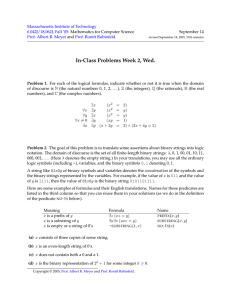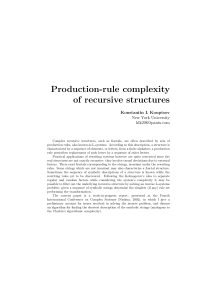18.417 Introduction to Computational Molecular ... Problem Set 4 Issued: October 12, 2004 Lecturer: Ross Lippert
advertisement
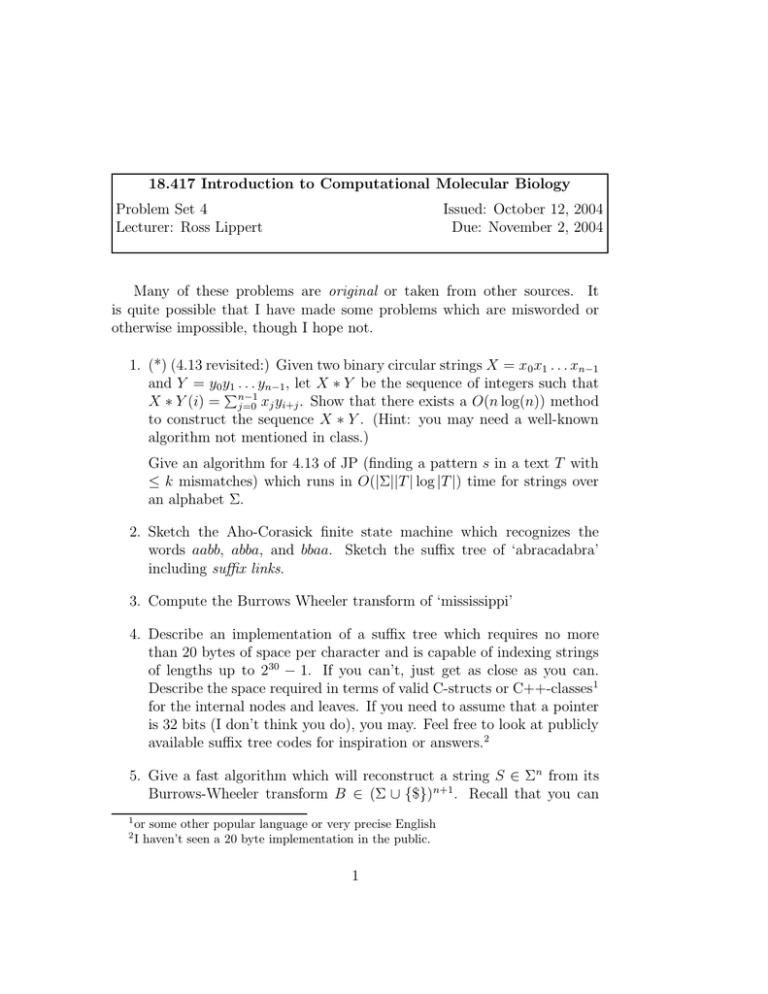
18.417 Introduction to Computational Molecular Biology
Problem Set 4
Lecturer: Ross Lippert
Issued: October 12, 2004
Due: November 2, 2004
Many of these problems are original or taken from other sources. It
is quite possible that I have made some problems which are misworded or
otherwise impossible, though I hope not.
1. (*) (4.13 revisited:) Given two binary circular strings X = x0 x1 . . . xn−1
and Y = y0 y1 . . . yn−1 , let X � Y be the sequence of integers such that
�n−1
xj yi+j . Show that there exists a O(n log(n)) method
X � Y (i) = j=0
to construct the sequence X � Y . (Hint: you may need a well-known
algorithm not mentioned in class.)
Give an algorithm for 4.13 of JP (finding a pattern s in a text T with
� k mismatches) which runs in O(|�||T | log |T |) time for strings over
an alphabet �.
2. Sketch the Aho-Corasick finite state machine which recognizes the
words aabb, abba, and bbaa. Sketch the suffix tree of ‘abracadabra’
including suffix links.
3. Compute the Burrows Wheeler transform of ‘mississippi’
4. Describe an implementation of a suffix tree which requires no more
than 20 bytes of space per character and is capable of indexing strings
of lengths up to 230 − 1. If you can’t, just get as close as you can.
Describe the space required in terms of valid C-structs or C++-classes1
for the internal nodes and leaves. If you need to assume that a pointer
is 32 bits (I don’t think you do), you may. Feel free to look at publicly
available suffix tree codes for inspiration or answers.2
5. Give a fast algorithm which will reconstruct a string S ∪ �n from its
Burrows-Wheeler transform B ∪ (� � {$})n+1 . Recall that you can
1
2
or some other popular language or very precise English
I haven’t seen a 20 byte implementation in the public.
1
2
Problem Set 4: 18.417
evaluate occ(B, i, c), the number of occurrences of character c at all
positions less than i, in O(log(n)) time.
Let � be the permutation which sorts of the suffixes of S, i.e. S[�(i) . . . n] <
S[�(i + 1) . . . n]. Give a variation on the above algorithm which con­
structs � from the BWT of S.
(Extra Credit:) Let �(i) be the length of the longest common pre­
fix of S[�(i) . . . n] and S[�(i + 1) . . . n]. Give a fast algorithm which
reconstructs � from the BWT of S.
6. (*) 9.9 of JP. Recall that a tandem repeat of S is an occurrence of a
substring of S of the form BB for some string B. (Hint: there is a
divide and conquer approach to this which is O(n log(n)) in time.)
7. 9.11 and 9.13 (they are closely related) of JP
8. 9.2 of JP. Random text refers to independent and identically distributed
latters with probability pi for letter i.
9. 3 Modern filtration methods do not use matching k-substrings as a
basis for filtration but use general k-subsequences. A k-subsequence,
sometimes called a gapped k-gram, is a concatenation of letters taken
from a set of k relative positions in S. The relative positions are of­
ten specified by a bit-string (called a mask) with exactly k 1s. For
example, for the string atttgctcgc, the 4-grams with mask 110101, are
attc, ttgt, ttcc, tgtg, gccc.
Given a binary string, R, we say that the mask M covers R when R
contains a substring which is 1 whereever the corresponding character
in M is 1.
(a) Let R be a binary string of length m containing ( 75 +�)m 1s (where
� is a positive constant). Prove that for sufficiently large m, all
such R are covered by the mask 11011 (i.e. there must be a sub­
string of length 5, which looks like 11g11, where g is either 0 or 1).
Now show that for any m, there exists a binary string containing
at least 43 m 1s that is not covered by 1111.
3
My thanks to Bin Ma of U. Western Ontario for these problems.
Problem Set 4: 18.417
3
(b) Let R be a randomly generated binary string of length 64, where
each position is 1 with probability 0.7. Write a program to gen­
erate one million such strings, and check how many of them are
covered by the masks 111010010100110111 and 11111111111 re­
spectively.
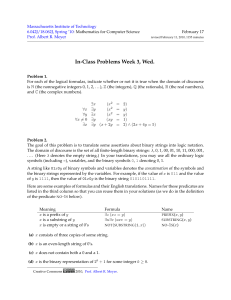

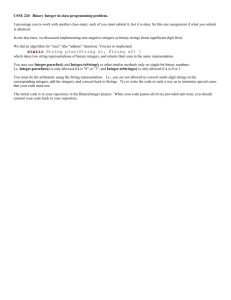

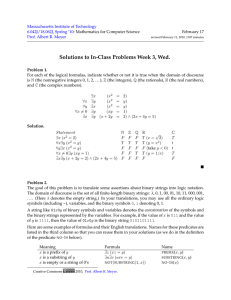


![Problem Wk.1.4.8: Substring [Optional]](http://s2.studylib.net/store/data/013337926_1-a8d9e314a142e3d0c4d9fe1b39539fba-300x300.png)
